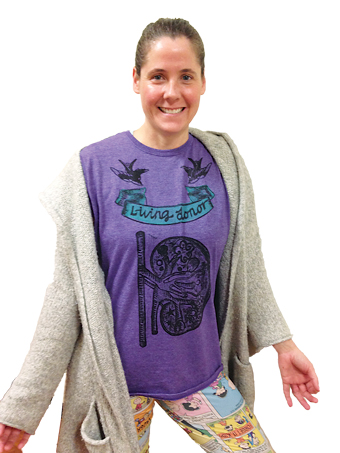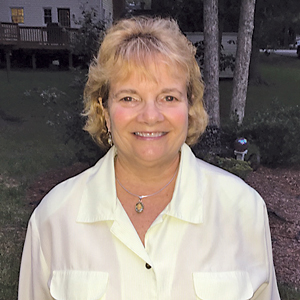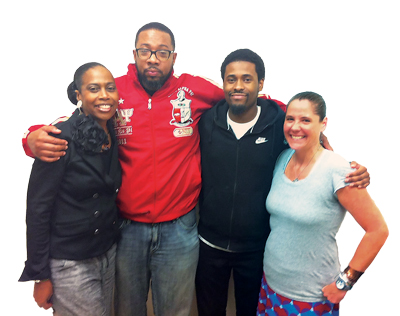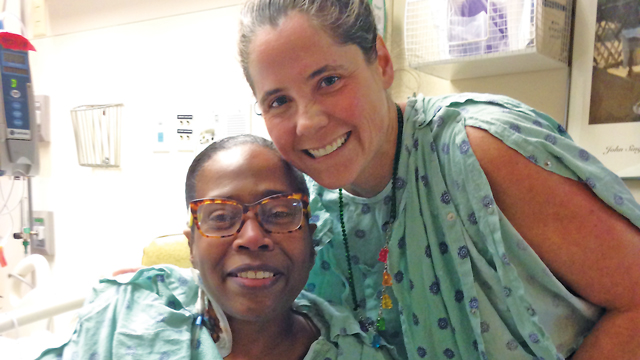Tracey Ridpath does a lot of thinking on daily walks near her Colonial Heights home. She thinks about her first-grade students at Tussing Elementary School. She thinks about her husband, Rick, and their teenage daughters, Casey and Camryn. She thinks about yoga, and new crafty projects for her creative mind to take on.
And for some time, another thought had been taking up residence in the back of her mind.
“Probably for several years, I have thought, if I ever knew anyone who needed a kidney, that might be something I would consider doing,” she says. “Then I was walking one morning before school and I thought, ‘Do you have to already know someone who needs it?’”
The idea had taken on new meaning with the city’s recent loss of Roger Green, whose life was ended by cancer in late 2015. Green was a pillar of the community, having served as executive director of the Chamber of Commerce after a long career in education. He had come into the Ridpaths’ lives years ago as principal of Colonial Heights Middle School, where Rick teaches history.
“He was an amazing person,” Ridpath says. “So kind, not judgmental… just a very positive person. At the middle school, he always said, every day, ‘Be good, do what is right, and always tell the truth.’ Anyone who was a student there can repeat that back to you word for word.”
A Plan Takes Shape
Not long after Green’s funeral, Ridpath and her husband were missing their friend and discussing what an inspiration he’d been. She remarked that if all he had needed to get well was a kidney, “all of Colonial Heights would have lined up to get tested.”
That’s when her thoughts about someday donating a kidney started to become a little less hypothetical. Emboldened by this new inspiration, but full of questions, Ridpath did what many of us do when a big question comes along – she Googled it. That led her to a list of screening questions and a phone call to VCU’s Hume-Lee Transplant Center in Richmond.
“It was about a 10-minute conversation,” Ridpath says. “Stuff about family medical history … do you have any children, any major surgeries, and why do you want to do this?”
What came next was a series of appointments, involving bloodwork and X-rays, and a chat with a psychologist to make sure she fully understood and was committed to this plan.
“Right up until the surgery, it’s almost like they’re trying to talk you out of it,” Ridpath says. “They want to give you every chance to say, ‘Nope, never mind,’ so that anyone who goes through with it is really serious about doing it.”
She had told Rick about her plans very early in the process, but they waited until her official approval to tell their daughters. With just a few questions, both understood the plan and were on board.
Telling her first-graders was a little more eventful.
“I told them all about what kidneys do, and how they stop working in some people, but since we have two sometimes, we can help by giving one away,” she said. “One child said, ‘WHAT? I don’t want someone to take my kidney!’ I had to reassure him that no one will ever take it if you don’t want them to. You have to want them to.”
Waiting for a Donor
Meanwhile, in Hampton, a woman named Djuna Paige had also been thinking a lot about kidney donation, but for a different reason. She had been diagnosed with lupus, a chronic disease in which the body attacks its own healthy tissues. Paige’s lupus was attacking her kidneys.
“They couldn’t do anything else to save my kidneys, so I was put on dialysis,” Paige says.
 Dialysis is a treatment that performs the important tasks of the kidneys when they are no longer able to: removing waste, salt, and excess fluid from the body. A single treatment can take hours, and must be repeated throughout the week.
Dialysis is a treatment that performs the important tasks of the kidneys when they are no longer able to: removing waste, salt, and excess fluid from the body. A single treatment can take hours, and must be repeated throughout the week.
“It was like a job,” Paige said. “I hated going. Some days I didn’t feel well after dialysis, so I had to go home and rest. Often I had doctors’ appointments on the days I was not on dialysis.”
That’s a tough adjustment for anyone. For Paige, it was a serious setback.
“We used to take trips,” she says. “The year I was diagnosed, I bought my husband a trip to Dubai, but my kidneys were still working then. Lupus and dialysis completely changed our lifestyle.”
Knowing that a healthy donor kidney was the only way to turn things around, Paige’s husband, JP, was eager to give one of his. Unfortunately, he was not a match for his wife.
After several months of waiting, Paige received a call from the transplant center about someone who could help.
“They said it was a ‘Good Samaritan’ who had decided to donate her kidney to someone in need,” she says. “And she was a match for me.”
Giving Life
To learn that a donor kidney is available is good news; to learn that a living donor kidney is available – that’s great news.

“A cadaver kidney will last about ten to twelve years after a successful transplant,” says Maureen Bell, renal transplant coordinator at VCU’s Hume-Lee Transplant Center. “So you may end up needing another transplant at some point.”
A living kidney, on the other hand, can last up to twenty years. And with simultaneous surgeries on the donor and recipient, the time the kidney spends outside the body is about twenty minutes – much better than the twenty-four hours a cadaver kidney might spend in transit.
“Living donors are special,” says Bell. “Not everyone can do it.”
That is why the process begins with screening questions – the same ones Bell asked Ridpath on that first phone call.
“We ask all about the person’s medical history, whether they smoke, whether they’ve had kidney stones, that sort of thing. We also ask why they would like to be a donor.”
That last question seems like small talk, but it’s key to the process. It’s important to establish that they are not hoping for any sort of compensation – financial, karmic, or otherwise. Although the donor’s related medical expenses are paid by the recipient’s insurance, the donation itself must be a gift, given freely with no expectations attached.
It’s also important to establish that no coercion is taking place. Bell recalls one young woman who confided that she felt pressure from her other family members to be the one who saved their relative, but she just wasn’t comfortable with the idea.
“That was the end of her donor testing,” Bell said. “This is not something a person should feel pressured or obligated to do.”
Kidney Swaps, Kidney Chains
When a patient has a friend or family member who can give a matching kidney, the process is relatively straightforward. When there isn’t a match in the patient’s circle of friends and family, they are placed on a waiting list for a cadaver kidney.
Sometimes, a living donor becomes available through a “kidney swap,” in which a willing donor doesn’t match his or her loved one, but may match another patient in the area. From these scenarios, the transplant center can arrange matching donor-recipient pairs. This way, two patients get the kidneys they need, from donors who were eager to give, but not a good match for their own loved ones.
Another, rarer option is a living donor with no particular recipient in mind, like Ridpath. In the transplant field, these donors are referred to as nondirected, altruistic, or “Good Samaritan” donors.
“We only have three or four altruistic donors per year,” says Bell. “Most people are inspired to give their kidney because they know someone who needs it.”

When an altruistic donor enters the picture, it kicks off a “kidney chain,” in which the donation can be paid forward many times. In Paige’s case, just as Ridpath was confirmed as a donor for her, her husband, JP, was matched as a donor for a young man in his twenties.
Whether it’s an altruistic donor or a swap arranged by the transplant center, both the donor and the patient remain anonymous throughout the process.
“We do all we can to maintain anonymity,” says Bell. “Of course, sometimes they happen to meet on their own.”
The Meeting
Ridpath says she knew going into the surgery on March 21 that her recipient would likely be nearby. But she knew nothing about her, except that she was a woman of about the same age.
“I had been praying about her a long time,” she says. “Praying that I would be medically fit to help someone, praying that she would be okay too, and that it would be life-changing for her.”
After the surgery was complete, Ridpath immediately wanted to know how the recipient was doing. She was elated to learn that her kidney was already doing its job in its new home. Through a staff member, she sent a gift of original artwork to her unknown recipient.
“It was a drawing of a kidney and it said, ‘This kidney enjoys candy, yoga …’ Just a few little fun things about where it had come from. I added a note that said, ‘I’ll be praying for you.’”
Later, another staff member came to Ridpath and said, “I have something from your recipient.”
“It was a book with a card,” Ridpath says, “and inside it she had put her name and phone number. So I knew she didn’t want to stay anonymous.”
The two exchanged some texts about their recovery and their hope to meet eventually.
“And then I stalked her on Facebook,” Ridpath says, laughing.
Having memorized Paige’s face there, she kept an eye out on her walks around the unit.
“I was walking with my pole and I was looking in the rooms,” she says, “and I was pretty sure I saw her. So I walked in and said, ‘Hey, I’m here to visit my kidney.’ And then we all started crying – lots of happy tears!”

And Since Then
The two have continued a friendship since that day, staying in touch on Facebook and exchanging texts and phone calls, celebrating their “kidneyversary” on the twenty-first of each month. And as Paige continues to thrive with her donated kidney, her husband’s kidney is still doing well in
its new home.
“I would do it again in a second,” Ridpath says. “I couldn’t have asked for a better outcome, and I feel great.”
She says the worst part of the recovery was not the pain or nausea.
“I must have Googled a hundred times, ‘How long do you have to wait before doing yoga,’” she says. “I was really restless about that.”
She also has one regret.
“I cannot believe I didn’t ask them to take a picture of my kidney,” she says. “No one ever gets to see their own kidney. That would have been awesome.”
How to Become a Donor
For others interested in becoming a kidney donor – either anonymously or for a loved one – Bell says the process can take a few months.
“It all starts with the donor questionnaire,” she says. “And from there, we take them step by step, through all the blood draws, the imaging, and making sure they are fully informed about everything along the way.”
The surgery itself is much improved in recent years, with the advent of robotic, laparoscopic procedures.
“It makes the surgery very precise,” she says, “so the recovery is much shorter and easier. Most patients are up and walking around by the next morning.”
And if the testing doesn’t produce a good enough match to result in surgery, sometimes it produces its own good outcome. Bell recalled a prospective donor whose imaging showed a grape-sized mass on one of her kidneys, something that raised alarm bells for her own health.
“She immediately started looking into that with her own doctors,” Bell says. “But that’s something she wouldn’t have even known was there if not for the donor testing.”
Overall, Bell says, becoming informed about the process is crucial.
“The more prospective donors know, the less they’re frightened,” she says. “And they can really enjoy improving someone’s quality of life.”




